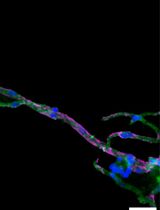- EN - English
- CN - 中文
Stereotaxic Injection of LPS into Mouse Substantia Nigra
向小鼠脑黑质立体定向注射LPS
发布: 2012年04月20日第2卷第8期 DOI: 10.21769/BioProtoc.153 浏览次数: 21943
Abstract
Stereotaxic injection is an attractive approach for studying genetic, cellular and circuit functions in the brain. Injection of anatomical tracers, site-targeted lesions and gene delivery by recombinant adeno-associated viruses and lentiviruses in mice are powerful tools to study nervous system development and disease mechanisms. Stereotaxic injection of LPS or 6-hydroxydopamine has been used to establish animal models of Parkinson’s disease, the most common neurodegenerative movement disorder. Importantly, this protocol allows the manipulation of gene expression in the targeted rodent brain regions and even targeted cell types or a subpopulation of cells in the injected region at any postnatal developmental stage up to adulthood.
Background
Materials and Reagents
- Eight-week-old male C57 mice or a variety of transgenic/knockout mice, body weight 20-25 g
- Nembutal
- Buprenorphine
- LPS (Escherichia coli 0111: B4) (Sigma-Aldrich)
- Sterile normal saline (0.9%) or other vehicle for your reagents
- Ocular lubricant (Puralube)
- 70% ethanol
- 4% paraformaldehyde
- Betadine
- Phosphate buffered saline (PBS)
- LPS stock solution (see Recipes)
Equipment
- Motorized microinjection pump
- Small-animal stereotaxic apparatus (mouse stereotaxic apparatus)
- Microinjection apparatus
- Dental drill and #1 burrs
- Microknife
- Scalpel (#10)
- Tissue forceps
- Gauze
- Autoclips/suture materials
- Stereotaxic frame
Procedure
文章信息
版权信息
© 2012 The Authors; exclusive licensee Bio-protocol LLC.
如何引用
Readers should cite both the Bio-protocol article and the original research article where this protocol was used:
- Gao, H. (2012). Stereotaxic Injection of LPS into Mouse Substantia Nigra. Bio-protocol 2(8): e153. DOI: 10.21769/BioProtoc.153.
- Gao, H. M., Kotzbauer, P. T., Uryu, K., Leight, S., Trojanowski, J. Q. and Lee, V. M. (2008). Neuroinflammation and oxidation/nitration of alpha-synuclein linked to dopaminergic neurodegeneration. J Neurosci 28(30): 7687-7698.
分类
神经科学 > 神经系统疾病
细胞生物学 > 组织分析 > 组织分离
您对这篇实验方法有问题吗?
在此处发布您的问题,我们将邀请本文作者来回答。同时,我们会将您的问题发布到Bio-protocol Exchange,以便寻求社区成员的帮助。
提问指南
+ 问题描述
写下详细的问题描述,包括所有有助于他人回答您问题的信息(例如实验过程、条件和相关图像等)。
Share
Bluesky
X
Copy link












